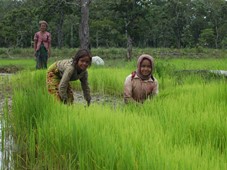
BirdLife's Local Conservation Groups (sometimes known as Site Support Groups) build on what are often strong economic, cultural, recreational and spiritual connections between people and places. Working with local people can help galvanise support for the conservation of Important Bird Areas, and develop the links between biodiversity conservation and more fulfilling and sustainable livelihoods.
In Denmark and elsewhere in Europe, the IBA Caretaker programme has successfully harnessed this local support for conservation, by involving people in monitoring, management and educational activities at sites, and helping them support and learn from one another. IBA Caretakers are a new kind of LCG, but there are many others. In developing countries, linking conservation to sustainable rural livelihoods takes a higher priority.
The project IBA Local Conservation Groups - harnessing community support for site conservation used the experiences of building LCGs in Europe, and in Africa, where much of the work on linking conservation and livelihoods was pioneered. Small grants were given to 13 BirdLife Partners for work with LCGs at 17 Important Bird Areas. At Lake Piso (Cape Mount IBA) in Liberia, for example, the BirdLife Partner worked with LCGs to reduce mangrove cutting for fuel, by introducing more efficient stoves for fish smoking. The women who smoke and sell the fish now spend less on wood, and have more money for their families.
In Cameroon, the Bakola people of Ngovayang Massif Forest were helped to obtain identity cards, an important step in winning recognition of their rights to use the forest. Better protection of several IBAs in Cambodia resulted in an increase of natural resources available to local people, creating new livelihoods opportunities. The BirdLife Partner in Lebanon established a Hima, a traditional Islamic approach to the conservation of natural resources, around the coastal village of Qoleileh, and supported a trained women's group to make and market local products, leading to a near-doubling of some household incomes.
At each site, the project worked with local people to establish their real needs, and then developed the most effective and culturally appropriate solution, providing training in technologies and techniques which the LCGs would be able to use without further external support. Conservation gains made in this way are far more likely to be sustained in the long term.
One ACJCF-funded project, "Environmental management for local groups at three IBAs in the northwest of Pichincha, Ecuador", went on to win one of the 2010 awards for Biodiversity Conservation and Development in Latin America.
The project also supported regional and national workshops on community-based conservation, exchange visits for sharing of good practice, and the publication of regional and global reports to share the lessons learned. With AVJCF support, LCG members from each region were able to attend BirdLife's 2008 World Conference in Buenos Aires, providing an unrivalled opportunity to share and learn.
Related Case Studies in other sections
Related Sites
Links
References
Compiled: 2015 Copyright: 2015
Recommended Citation:
BirdLife International (2015)
IBA Local Conservation Groups - harnessing community support for site conservation.
Downloaded from https://datazone.birdlife.org/sowb/casestudy/iba-local-conservation-groups-harnessing-community-support-for-site-conservation on 22/12/2024